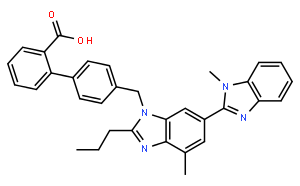In the telmisartan (0.1, 0.3, and 1 mg/kg)-treated rats, the specific binding of [H]telmisartan to the surface of living RVSMC is saturable and increases quickly to reach equilibrium within 1 h. Telmisartan dissociates very slowly from the receptor with a dissociation half-life (t1/2) of 75 min, which is comparable with candesartan and almost 5 times slower than angiotensin II (AngII). In vivo, telmisartan blunts the blood pressure response to exogenous AngII dose dependently. Telmisartan (10 mg/kg/d) administration effectively suppresses aneurysm pathogenesis after PPE infusion as well, regardless of whether treatment is initiated before or after aneurysm creation or continues for a limited or extended time. Telmisartan treatment is associated with reduced messenger RNA levels for CCL5 and matrix metalloproteinases 2 and 9 in aneurysmal aortae, with no apparent effect on PPARγ-regulated gene expression. Telmisartan (1 mg/kg/day) significantly ameliorates neuronal loss and the spatial acquisition impairment in 5XFAD mice, but without any changes of NeuN expression in the hippocampus layer. Telmisartan (1 mg/kg/day) treatment reduces amyloid burden and microglial accumulation in 5XFAD mice brain, induces microglial polarization towards neuroprotective phenotype, but does not alter the expression levels of NEP and IDE in 5XFAD mice specific brain areas. Telmisartan (0.05, 0.1, 1 mg/kg, p.o.) shows significant reduction in immobility time, antagonizes depression and anxiety, and also significantly attenuates serum cortisol, NO, IL-6 and IL-1β in rats. Telmisartan (50 μg, i.p.) leads to a 73.2% reduction in tumor growth in mice bearing xenografts derived from OE19 cells. Furthermore, miRNA expression is significantly altered by telmisartan in vivo.
Medlife has not independently confirmed the accuracy of these methods. They are for reference only.



 扫码关注公众号
扫码关注公众号